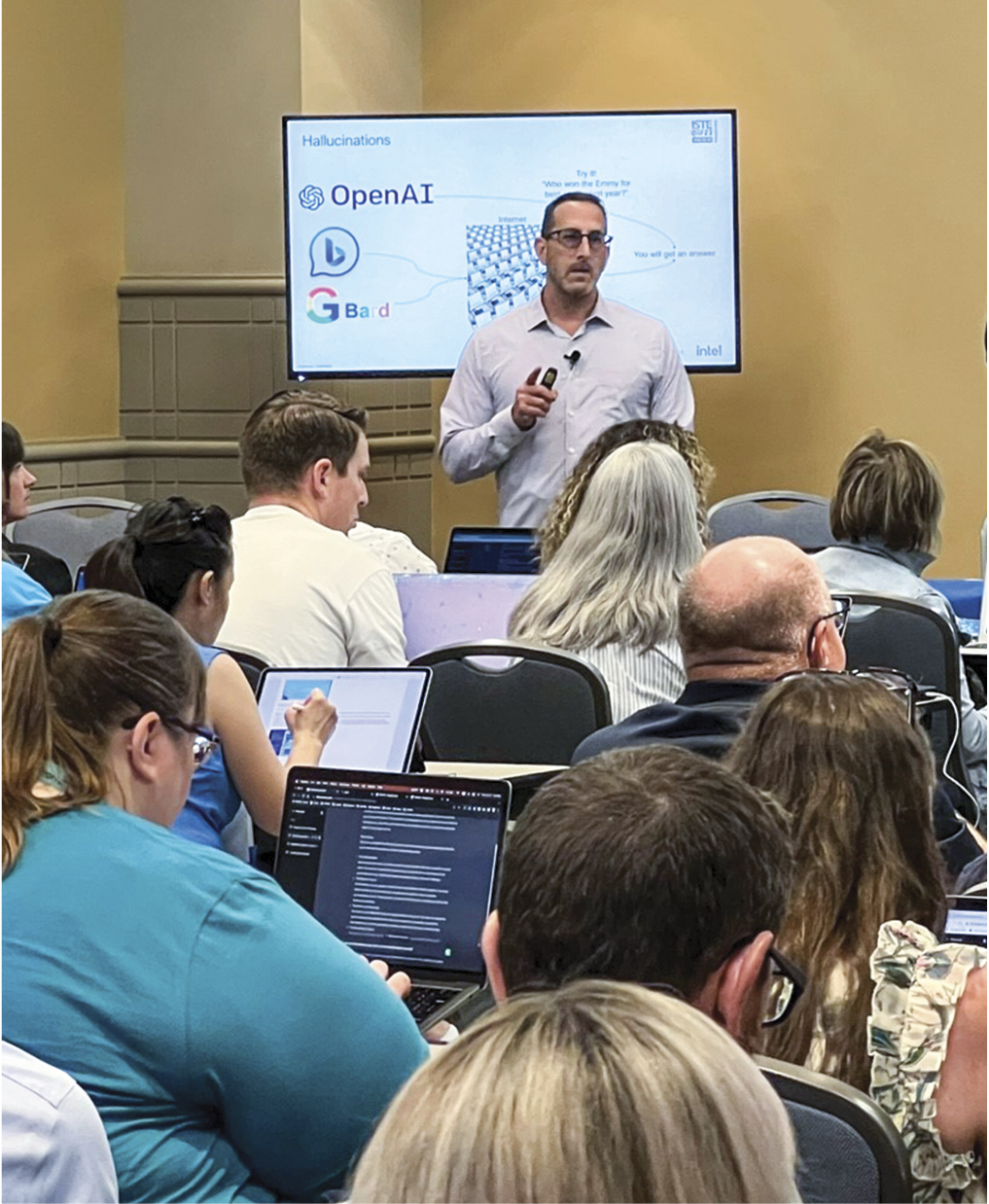Exploring ChatGPT’s Potential
October 02, 2023
Collective insights from superintendents gathered at a recent forum lead to advice on navigating AI’s opportunities and concerns

Artificial intelligence has the potential to revolutionize K-12 education by providing new ways for students to learn and for teachers to teach. Since the launch last November of ChatGPT, an AI chatbot developed by OpenAI, the past year has seen an explosion of ideas and opinions about how to incorporate new AI tools.
The tools currently available to educators are all considered narrow AI (or weak AI) because they operate within the constraints of the training data and architecture it is based on. Unlike what’s known as artificial general intelligence, these tools cannot autonomously learn, adapt or develop new skills outside of a pre-defined framework.
As educators explore the integration of these fast-developing technologies into their classrooms, school system leaders will need to address the myriad opportunities, concerns and challenges that arise. We see several key themes emerging from a series of conversations among a group of 35 superintendents at an international education leaders’ conference early in 2023.
Their insights came from ThoughtExchange’s collective intelligence and survey platform and a weekend of robust and forward-thinking conversations. The ChatGPT app had just been released, and it felt like a frontier in many ways. Although we have come a long way in a short time, much of this conversation remains uncharted frontier.
By sharing their thinking, we aim to provide guidance for school administrators to harness the potential of AI while navigating the complexities of implementation.
From safety and security to teacher support, curriculum and instruction, student learning outcomes, professional development, community involvement and ethical considerations, the concerns surrounding AI integration in education are sundry and diverse. To address them, schools will need to develop a holistic approach that combines clear guidelines, comprehensive support and active community involvement. Responsible integration of AI technologies in education ultimately may lead to more innovative, adaptable and engaging learning experiences for students.
Threatened Staff
A major theme from this gathering related to the development of effective strategies to support teachers who feel threatened by artificial intelligence technology. One superintendent highlighted the importance of avoiding an unproductive narrative among the staff. To help teachers understand how it can be used, teachers need opportunities to see AI technology in action through workshops and classroom visits. They also will need professional training on integrating AI into their instruction.
We see a multi-step approach:
No. 1: Awareness. Organize informational sessions, webinars or workshops to introduce teachers to the benefits and capabilities of AI. Share success stories and use illustrative cases to demonstrate how AI can enhance their teaching and improve learning outcomes.
No. 2: Training. Provide comprehensive training, resources, tutorials and guides to help teachers become comfortable with AI, ensuring ongoing support for troubleshooting and questions.
No. 3: Collaboration. Build cooperative practices by creating spaces for teachers to share experiences, tips and best practices when using AI tools through online forums, social media groups or in-person meetings.
No. 4: Incentives. Encourage adoption of new technology through incentives, including recognition for innovative use, financial incentives for training completion or achieving milestones and professional development opportunities.
No. 5: Integration. Work with teachers to integrate AI tools into the existing curriculum and lesson plans, providing templates and examples to illustrate potential applications.
No. 6: Evaluation. Evaluate the impact of AI tools on teaching and learning by gathering feedback from teachers and students, analyzing data and identifying areas for improvement. Use this information to refine implementation and provide additional support as needed.
Developing Competencies
A second theme revolved around curriculum and instruction, particularly at the high school level. To address this, we suggest focusing on developing new skills and competencies for students. Students must learn about AI and its potential impact on society and develop new ways of learning that prioritize conversation and observation. Additionally, we must consider integrating AI into the curriculum in ways that align with existing standards.
To address the changing landscape of education and evolving workforce needs, a shift in focus toward developing specific new skills and competencies for students becomes crucial. This includes technical proficiencies, such as understanding basic algorithms and coding, and the capacity to engage with AI systems.
We also want to enhance their critical thinking skills so they can approach AI not just as end-users but as informed and discerning citizens. These skills can enable them to understand the potential impact of AI on society, economy and ethics and to participate actively in debates surrounding AI use and regulation.
Creating opportunities for students to learn these competencies requires innovative approaches to instruction. The use of a tool such as ChatGPT can provide rich, interactive and adaptive learning experiences. In English or social studies classrooms, teachers are beginning to use the GPT language model to simulate interactive dialogues with historical or literary characters. In science or math, teachers are beginning to use it to solve problems step by step or to generate new problems for students to tackle. Such AI-facilitated experiential learning prioritizes conversation and observation, fostering students’ understanding in a more immersive and engaging way.
The successful integration of AI into the curriculum involves careful consideration of existing standards and learning outcomes. AI should not be introduced as an isolated subject but woven seamlessly into the broader educational objectives. In other words, the goal is not to simply add a new layer to the curriculum but to recalibrate the curriculum such that the AI-based activities align with and enhance the existing standards.
Colleagues around the country are working to develop new skills and competencies for middle school students to thrive in a world with AI by implementing an interdisciplinary AI-focused curriculum. This includes teaching AI concepts, promoting critical thinking about AI’s impact on society and adopting new assessment methods. We should strategically design a comprehensive AI literacy curriculum, collaborate with key stakeholders to gather feedback on the proposed course, identify potential challenges and secure the resources for implementation.
We foresee the AI literacy course as a mandatory or elective subject that promotes project-based learning to help students acquire practical skills and comprehend the real-world impact of AI.
Assessment Practices
Student learning outcomes emerged as a theme, with a need to use AI to develop critical thinking and curiosity in students. Assessment of students in this recalibrated curriculum would need to evolve too.
Traditional standardized testing may not sufficiently capture the spectrum of skills and knowledge students would gain. Thus, alternative modes of assessment, such as project-based assignments or performance tasks where students demonstrate their ability to engage with AI systems, should be incorporated. To address this, we must shift assessment practices toward conversation and observation and encourage students to engage in research, inquiry and other forms of critical thinking.
Examples of AI use in assessments include these three:
Adaptive testing. AI-powered adaptive tests automatically adjust the difficulty level of questions based on a student’s performance, generating practice questions tailored to each student’s ability level. AI can analyze responses in real-time, provide clarifications and tailor questions to better identify strengths and weaknesses.
Automated essay draft reviews and scoring. AI can assess grammar, syntax, coherence and content, helping students identify areas for improvement before submitting their final work. This saves teachers time and allows students to receive valuable feedback more quickly. AI also can provide writing assistance, helping students generate ideas, create outlines and refine arguments.
Performance-based assessment. AI can analyze students’ performance on complex tasks such as problem solving, group projects and presentations. By evaluating a student’s actions, decisions and interactions, AI can help identify areas of strength and areas that need improvement, particularly in assessing soft skills such as collaboration, critical thinking and communication.
In all these examples, AI has the potential to make assessment more efficient, accurate and personalized, while also providing valuable insights that help educators tailor their instruction to better meet the needs of their students. By leveraging AI’s capabilities, teachers and administrators can enhance the educational experience for students and educators.
The Right Question
Before we rush headlong into the future with the answer, maybe it’s best we step back and make sure we are asking the right question. Instead of asking “what should we do?” perhaps a better question is “how should we do it?” Successful integration of AI technologies will find us relying on the basic leadership skills we all have been using since we first began in educational administration: listening, seeking feedback, supporting teachers, planning, problem solving and iterating, to name a few.
Integrating AI in education holds the potential to transform teaching and learning methods. Nevertheless, we must proceed cautiously and thoughtfully, addressing concerns of safety and security, teacher support, curriculum and instruction, student learning outcomes, professional development, community involvement and ethical considerations in AI usage.
QUINTIN SHEPHERD is superintendent of Victoria Independent School District in Victoria, Texas. DAVE MACLEOD is CEO of Thought Exchange in Rossland, British Columbia, Canada.
Advertisement
Advertisement
Advertisement
Advertisement



.png?sfvrsn=ffae7191_7)